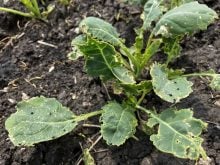Tom Jensen of International Plant Nutrition Institute says researchers found more than 25 years ago that anhydrous ammonia was pound for pound more effective than broadcasting fertilizer. It turned out it was the banding that was the key to the success.
However, it meant a second application step, and producers’ appreciation for single pass seeding solutions grew as they moved to reduced tillage and increased acreage.
Putting mobile nutrients such as nitrogen and sulfur in a band that is a plant-safe distance to the young seedlings was a first step.
Read Also

Growing garlic by the thousands in Manitoba
Grower holds a planting party day every fall as a crowd gathers to help put 28,000 plants, and sometimes more, into theground
The less mobile nutrients, such as phosphorus and potassium, need to be placed in the path of plant.
“If you broadcast the phosphorus, the way you might nitrogen, you have to use twice the rate to get the same uptake into the plant if you had placed it with the seed,” Jensen said.
“The same thing goes for potassium, copper and zinc,” he said.
Banding helps reduce nitrogen losses to the air or heavy rain events.
Jeff Schoenau of the University of Saskatchewan said liquid 28-0-0 UAN can be dribble banded, while NH3 can be effectively applied in the fall.
Jensen said farmers in the U.S. corn belt have a longer season to evaluate their crops and feed them with split applications of nitrogen.
Farmers in Western Canada and the Great Plains states can get almost the same results from a well-placed fertilizer supply during seeding.
“Split applications can be very effective if the weather supports it, but broadcasting some urea, or streaming some UAN down, can result in having it stranded at the soil’s surface it turns dry,” he said.
Schoenau said an early growing season application of top-dressed nitrogen will tend to boost yields, provided it reaches its targeted plants, while a later application will tend to boost protein in cereals.
Rigas Karamanos of Koch Industries said deep banding mobile nutrients remains the gold standard for low losses and effectively reaching crops.
However, a growing list of methods are available that can protect young plants while allowing high rates of otherwise toxic fertilizer to be applied in or beside the seed row. These tools can also help stabilize nitrogen when it is top-dressed, or even in a fall-banding program.
Polymer and sulfur coating are the two main systems. They create a physical barrier between the plant and urea and blocks and slows its breakdown in the soil.
Coated products rely on soil moisture to diffuse through the coating and break it down, releasing the nutrient within. Temperature also plays a role.
Water-insoluble, semi-permeable and impermeable material delays the release of nitrogen from the urea. Thickness, total coverage and uniformity of the coating on the granule are critical to plant safety and timing of the product’s release.
Poly coatings are not significantly affected by soil properties such as pH, salinity, soil texture, microbial activities or cation exchange capacity. The coating makes it possible to more accurately predict the nutrient release rate from those products when compared to sulfur-coated urea and stabilized products.
“If you want to put very high rates of fertilizer down with the seed, in one pass, you need to go with polymer products for the ultimate protection,” Karamanos said.
“When you are broadcasting, some of our environments are wet enough for the polymers to be released.”
However, he said nitrification inhibitors are more effective for broadcasting and streaming in most cases in Western Canada, whether in fall or as top-dressed product.
“Stabilized products are not the same thing. What they do is inhibit the urease, so it doesn’t convert the urea into ammonium or they inhibit nitrification. Some of the nitrogen inhibitors are bacteria-static, which stop the bugs, while others are bactericides,” he said.
“It doesn’t mean they won’t come back, but it slows the local processes.”
Jensen said losses can be as high as 40 percent if urea is broadcast onto damp soils and warm, dry windy conditions follow.
- The final part in this series will look at best practices in fertility management. To see a listing of the available release control technologies and to view the video interviews, visit producer.com.

















